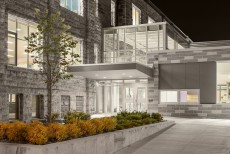The Evolution of School Design
“What, exactly, can the history of school building design tell us not only about the present, but more importantly, what we must learn for the future?”
Perspectives from our Partners
School design has changed dramatically over the years. One thing that hasn’t, though, is how our school buildings reflect the society that built them. Think of the one-room schoolhouse of the nineteenth century, where children of all ages were gathered in the same space, with a single teacher. The setting was an expression of the agrarian priorities of the time; day-to-day life took its cues from the needs of the farming timetable, vestiges of which—late start and early dismissal times, summer vacation—still exist today. The schoolhouse was convenient to farms and fields, where children were expected to work either before, after, or through harvest and planting times. The focus was on convenience; education was secondary and rudimentary. Thankfully, almost everything has changed over the course of 150 years.
Practical factors compelled this shift, and, as ever, where we are is very much the product of where we’ve been. Like anywhere in the Western world, Ontario’s population—and thus student body—was kept at bay in the early part of the twentieth century by such grim factors as the First World War and the Great Depression.
With the industrial era, more people moved into cities and school buildings grew from basic facilities, adding entire floors and wings to accommodate increasing numbers of students in a more urban environment. Which, it should be noted, is not so terribly different from our approach today.
After the Second World War the Baby Boom produced a whole new population and set of challenges. With exploding numbers, school buildings, in the words of architects at the time, were “extruded like sausages.” It was a factory-style education system, with double-loaded corridors designed in modules, that were designed to TK.
Given the pace at which schools went up, they were not particularly well-built. There are rare exceptions, where Modernist notions of elegance and simplicity allowed some humanity to be slipped in under the radar, but these are few and far between. Fundamentally, school design was reactive.
As a result, the twenty-first-century built environment for the all-important task of teaching our children is significantly less the product of forward-thinking innovation, than it is an ingrained culture of expediency. This has been the dominant mode for more than a century.
We’ve come a long way from there, and we now know the value of innovation over reaction. As an architect, I have been designing, building, and operating schools for the past 22 years. The question I now have to ask is: What, exactly, can the history of school building design tell us not only about the present, but more importantly, what we must learn for the future? Educational theory and practice itself has shifted dramatically over the course of this period, from the top-down model of a teacher at the front of the classroom preaching a rote curriculum to students in tidy rows to a more free-flowing discussion model, with children sitting around tables, talking and sharing ideas under guidance.
With teachers shifting into mentor and coach roles, encouraging young minds to be curious and innovative, education has embraced the present moment, and indeed, the future. But what of our school buildings? Look out the window from almost any of these progressive, exchange-focused classroom scenes, and what do we see? In Toronto, it’s rusted chain link fence and crumbling tarmacs, peeling paint and any number of outdated, inefficient building ills, to say nothing of the learning environments themselves.
Teachers need their built environment to reflect the here and now of a new era of education. That much can’t be argued. What also can’t be ignored, unfortunately, is how the current state of school buildings is significantly out of key with the goals and techniques of contemporary educational practice.
How to close this gulf, between current educational practice and the very buildings in which it takes place, is no easy task. And yet, it must be embraced as an element of the educational experience that is nearly as significant as teaching itself. In the scant few opportunities where architects have had the opportunity to design buildings in tune with teaching today, those innovations are broadly reflected.
In new buildings, you’ll see the gap between theory and physical environment gap disappear. Libraries can be found at the core of the building, with classrooms open to it through transparent walls. Daylight is everywhere—gone are the cinder-block walls—and the school is able to come together, indeed, to exist, in a functional, day-to-day way, as a community.
These opportunities, however, have thus far been few. There are, of course, reasons. The Toronto District School Board, for example, reported a $3.2 billion backlog in school renewal. The majority of our schools in Ontario are post-war, aging and crumbling, to say nothing of their structures that are ill-suited for contemporary education.
This brings up the very urgent question: What will our schools look like 10, 20, or 30 years from now? Surely, I have to believe, not like this. But it will take remarkable creative problem solving both from the government agencies that pay for it, and the creative field of architecture that I believe is best-equipped to offer those solutions.
It’s not too late. Children will go to school somewhere. We can help that to be a bricks-and-mortar parallel to the progressive, forward-thinking educational experience with which they’ll be engaged. After all, this is what we do. It’s my hope that this publication will help open that conversation wide enough for it to be substantive, and loud enough to be heard.
